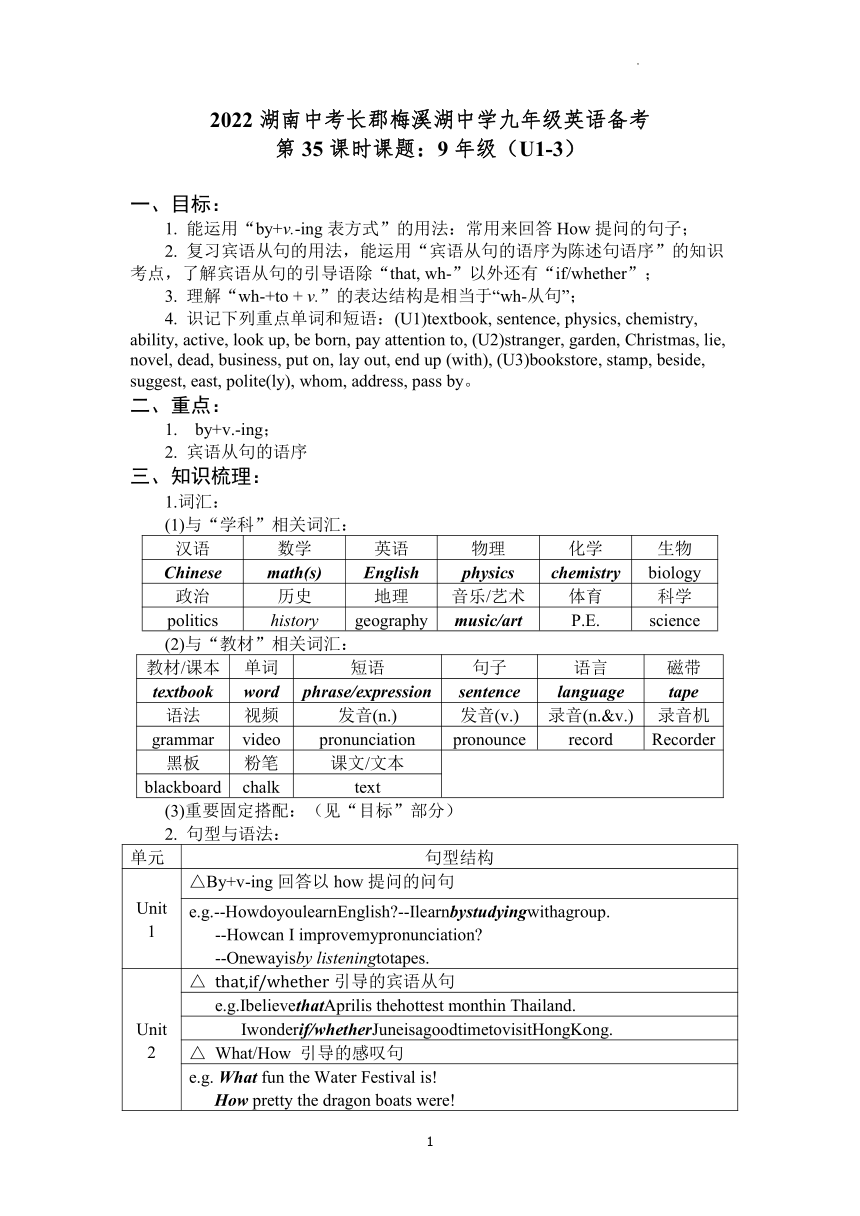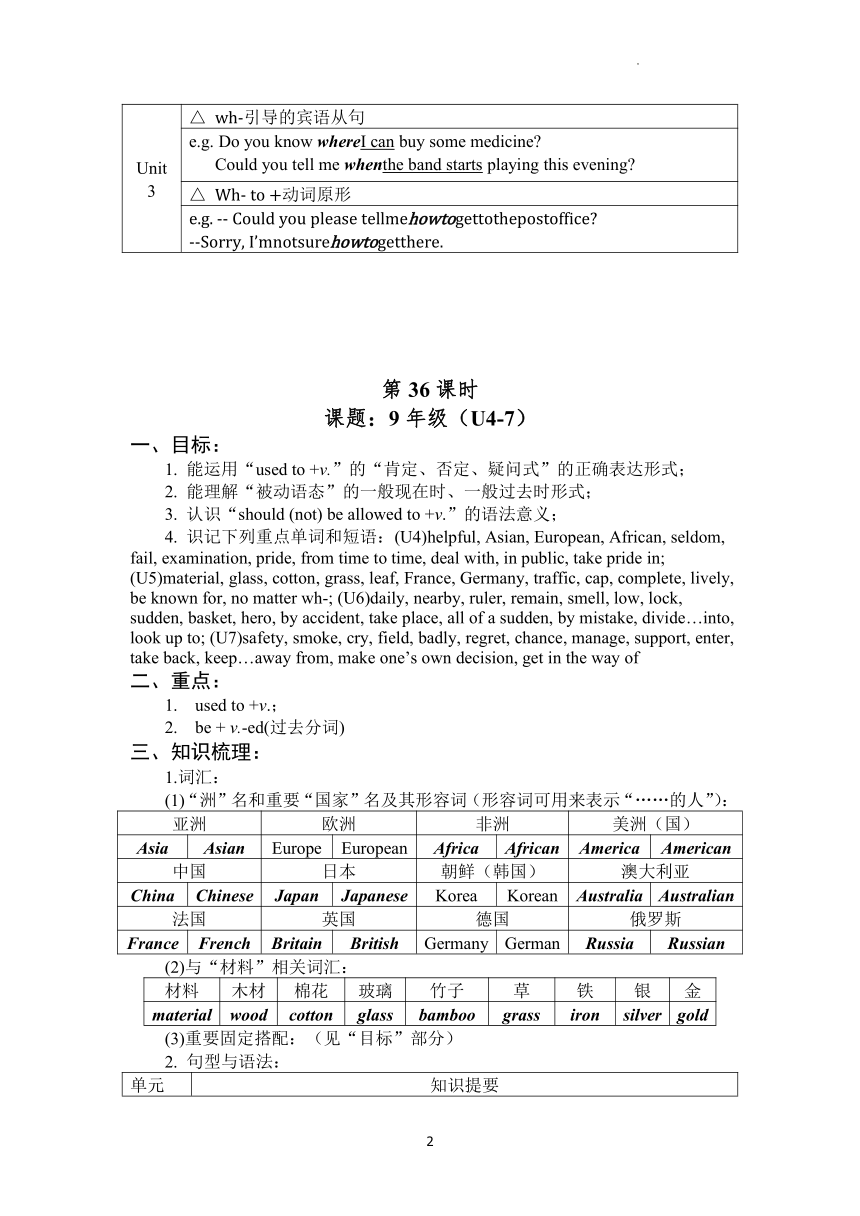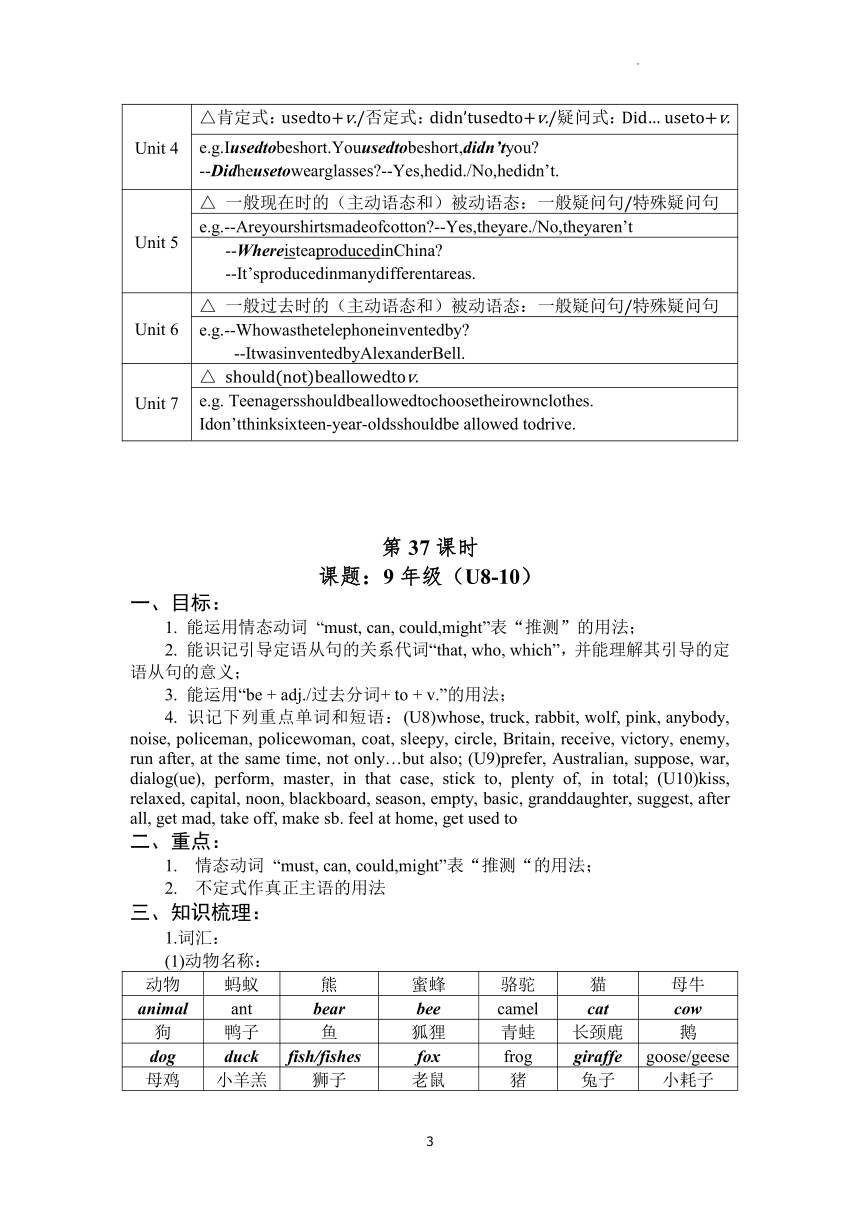2022年湖南中考长郡梅溪湖中学九年级英语备考教案
文档属性
| 名称 | 2022年湖南中考长郡梅溪湖中学九年级英语备考教案 |

|
|
| 格式 | docx | ||
| 文件大小 | 56.7KB | ||
| 资源类型 | 教案 | ||
| 版本资源 | 通用版 | ||
| 科目 | 英语 | ||
| 更新时间 | 2022-04-05 18:56:29 | ||
图片预览



文档简介
2022湖南中考长郡梅溪湖中学九年级英语备考
第35课时课题:9年级(U1-3)
一、目标:
1. 能运用“by+v.-ing表方式”的用法:常用来回答How提问的句子;
2. 复习宾语从句的用法,能运用“宾语从句的语序为陈述句语序”的知识考点,了解宾语从句的引导语除“that, wh-”以外还有“if/whether”;
3. 理解“wh-+to + v.”的表达结构是相当于“wh-从句”;
4. 识记下列重点单词和短语:(U1)textbook, sentence, physics, chemistry, ability, active, look up, be born, pay attention to, (U2)stranger, garden, Christmas, lie, novel, dead, business, put on, lay out, end up (with), (U3)bookstore, stamp, beside, suggest, east, polite(ly), whom, address, pass by。
二、重点:
1. by+v.-ing;
2. 宾语从句的语序
三、知识梳理:
1.词汇:
(1)与“学科”相关词汇:
汉语 数学 英语 物理 化学 生物
Chinese math(s) English physics chemistry biology
政治 历史 地理 音乐/艺术 体育 科学
politics history geography music/art P.E. science
(2)与“教材”相关词汇:
教材/课本 单词 短语 句子 语言 磁带
textbook word phrase/expression sentence language tape
语法 视频 发音(n.) 发音(v.) 录音(n.&v.) 录音机
grammar video pronunciation pronounce record Recorder
黑板 粉笔 课文/文本
blackboard chalk text
(3)重要固定搭配:(见“目标”部分)
2. 句型与语法:
单元 句型结构
Unit 1 △By+v-ing回答以how提问的问句
e.g.--HowdoyoulearnEnglish --Ilearnbystudyingwithagroup. --Howcan I improvemypronunciation --Onewayisby listeningtotapes.
Unit 2 △ that,if/whether引导的宾语从句
e.g.IbelievethatAprilis thehottest monthin Thailand.
Iwonderif/whetherJuneisagoodtimetovisitHongKong.
△ What/How 引导的感叹句
e.g. What fun the Water Festival is! How pretty the dragon boats were!
Unit 3 △ wh-引导的宾语从句
e.g. Do you know whereI can buy some medicine Could you tell me whenthe band starts playing this evening
△ Wh- to +动词原形
e.g. -- Could you please tellmehowtogettothepostoffice --Sorry, I’mnotsurehowtogetthere.
第36课时
课题:9年级(U4-7)
一、目标:
1. 能运用“used to +v.”的“肯定、否定、疑问式”的正确表达形式;
2. 能理解“被动语态”的一般现在时、一般过去时形式;
3. 认识“should (not) be allowed to +v.”的语法意义;
4. 识记下列重点单词和短语:(U4)helpful, Asian, European, African, seldom, fail, examination, pride, from time to time, deal with, in public, take pride in; (U5)material, glass, cotton, grass, leaf, France, Germany, traffic, cap, complete, lively, be known for, no matter wh-; (U6)daily, nearby, ruler, remain, smell, low, lock, sudden, basket, hero, by accident, take place, all of a sudden, by mistake, divide…into, look up to; (U7)safety, smoke, cry, field, badly, regret, chance, manage, support, enter, take back, keep…away from, make one’s own decision, get in the way of
二、重点:
1. used to +v.;
2. be + v.-ed(过去分词)
三、知识梳理:
1.词汇:
(1)“洲”名和重要“国家”名及其形容词(形容词可用来表示“……的人”):
亚洲 欧洲 非洲 美洲(国)
Asia Asian Europe European Africa African America American
中国 日本 朝鲜(韩国) 澳大利亚
China Chinese Japan Japanese Korea Korean Australia Australian
法国 英国 德国 俄罗斯
France French Britain British Germany German Russia Russian
(2)与“材料”相关词汇:
材料 木材 棉花 玻璃 竹子 草 铁 银 金
material wood cotton glass bamboo grass iron silver gold
(3)重要固定搭配:(见“目标”部分)
2. 句型与语法:
单元 知识提要
Unit 4 △肯定式:usedto+v./否定式:didn’tusedto+v./疑问式:Did… useto+v.
e.g.Iusedtobeshort.Youusedtobeshort,didn’tyou --Didheusetowearglasses --Yes,hedid./No,hedidn’t.
Unit 5 △ 一般现在时的(主动语态和)被动语态:一般疑问句/特殊疑问句
e.g.--Areyourshirtsmadeofcotton --Yes,theyare./No,theyaren’t
--WhereisteaproducedinChina --It’sproducedinmanydifferentareas.
Unit 6 △ 一般过去时的(主动语态和)被动语态:一般疑问句/特殊疑问句
e.g.--Whowasthetelephoneinventedby --ItwasinventedbyAlexanderBell.
Unit 7 △ should(not)beallowedtov.
e.g. Teenagersshouldbeallowedtochoosetheirownclothes. Idon’tthinksixteen-year-oldsshouldbe allowed todrive.
第37课时
课题:9年级(U8-10)
一、目标:
1. 能运用情态动词 “must, can, could,might”表“推测”的用法;
2. 能识记引导定语从句的关系代词“that, who, which”,并能理解其引导的定语从句的意义;
3. 能运用“be + adj./过去分词+ to + v.”的用法;
4. 识记下列重点单词和短语:(U8)whose, truck, rabbit, wolf, pink, anybody, noise, policeman, policewoman, coat, sleepy, circle, Britain, receive, victory, enemy, run after, at the same time, not only…but also; (U9)prefer, Australian, suppose, war, dialog(ue), perform, master, in that case, stick to, plenty of, in total; (U10)kiss, relaxed, capital, noon, blackboard, season, empty, basic, granddaughter, suggest, after all, get mad, take off, make sb. feel at home, get used to
二、重点:
1. 情态动词 “must, can, could,might”表“推测“的用法;
2. 不定式作真正主语的用法
三、知识梳理:
1.词汇:
(1)动物名称:
动物 蚂蚁 熊 蜜蜂 骆驼 猫 母牛
animal ant bear bee camel cat cow
狗 鸭子 鱼 狐狸 青蛙 长颈鹿 鹅
dog duck fish/fishes fox frog giraffe goose/geese
母鸡 小羊羔 狮子 老鼠 猪 兔子 小耗子
hen lamb lion mouse/mice pig rabbit rat
绵羊 蛇 老虎 狼 斑马 动物园
sheep snake tiger wolf/wolves zebra zoo
(2)交通工具:
交通 交通 车辆 自行车 小船 小汽车
traffic transportation vehicle bike/bicycle boat car
飞机 火车路 轮船 火车 卡车
plane railway ship train truck
(3)词类的“派生”与“转换”:
① 动词转换成名词:
[v.(-ment) → n.] e.g. advertisement, agreement, development, treatment;
[v.(-ion/tion/sion) → n.] e.g. communication, competition, conversation, decision, direction, discussion, education, examination, information, introduction, invention, operation, pronunciation, translation;
[v.(-er/or) → n.(……的人)] e.g. cooker, farmer, speaker, teacher, visitor, waiter, winner;
其它动词变名词的例词:discover-discovery, please-pleasure, advise-advice, weigh-weight;
② 名词转换成形容词:
[n.(-ful/less) → adj.] e.g. care-careful-careless, help-helpful-helpless, use-useful-useless, wonder-wonderful;
[n.(-y) → adj.] e.g. cloud-cloudy, fun-funny, snow-snowy, sun-sunny, wind-windy, day-daily, friend-friendly, health-healthy, need-necessary, sleep-sleepy;
[n.(-ous) → adj.] e.g. danger-dangerous, humour-humourous, nervous;
[n.(-al) → adj.] e.g. medicine-medical, nature-natural;
[n.(-a/an) → adj.] e.g. Asian, African(更多例词见第28课时词汇归纳);
[方位名词.(-ern) → adj.] e.g. east-eastern, south-southern, west-western, north-northern;
其它名词变形容词的例词:gold-golden,
③ 形容词转换成名词:
[adj.(改t为ce) → n.] e.g. different-difference, important-importance, silent-silence;
[adj.(-y) → n.] e.g. difficult-difficulty, honest-honesty, social-society, active-activity;
其它形容词变名词的例词:busy-business, true-truth;
④其他转换词例:science-scientist, tour-tourist, live-alive, wake-awake, sleep-asleep
(4)重要固定搭配:(见“目标”部分)
2. 句型与语法:
(1)情态动词表推测的用法:
句式 must can could might
肯定 一定 可能 可能 可能
否定 × 不可能 可能不 可能不
(2)引导定语从句的关系代词that, who, which基本用法归纳:
先行词充当定语从句中的 指人 指物 可否省略
主语 who, that which, that 关系词不能省略
宾语 who(m), that which, that 关系词可以省略
(3)不定式的两个用法:
①用作真正的主语,基本句型结构如下:
It(形式主语) is +adj. + (for/of sb.) to do sth.(真正的主语)
②用作主语的补助语(简称“主补”),其基本句型结构如下:
sb. be +过去分词+ to do sth.
(4)单元知识概要:
单元 知识提要
Unit 8 △“所属物”的表达法
e.g.--Whosevolleyballisthis --ItmustbeCarla’s/hers./ItmustbelongtoCarla/her.
△情态动词(must,might,can’t)表推测的用法
e.g. 1)--Whosebasketballisthis --ItmustbePeter’s.Helovesfootballverymuch. 2)--Whosehairbandisthis --Itcould/mightbeAnna’s.Shehaslonghair. 3)--Whatdidyouseelastnight --I’mnotsure,butitcan’tbeadog.
Unit 9 △ that,who,which引导的定语从句
e.g. I lovemusicthat/which I cansingalongwith. Helikesmusicianswhoplaydifferentkindsofmusic.
Unit 10 △ 不定式的两个用法:1)besupposed/expectedtodosth.; 2)It’s+adj.todosth.
e.g.--Am I supposedtowearjeans --Yes,youare./No,youareexpectedtowearasuitandtie. --Whenwereyousupposedtoarrive --Iwassupposedtoarrive at 7:00
e.g.--Isitpolitetokeepotherswaiting --No,itisn’t. --Isitimportanttobeontime --Yes,itis.
第38课时
课题:9年级(U11-14)
一、目标:
1. 能运用“使役动词make”带“去to不定式”和形容词作“宾语补足语”的基本用法;
2. 能理解“过去完成时态”的基本用法;
3. 识记下列重点单词和短语:(U11)drive, examine, weight, courage, agreement, drive sb. mad, the more…the more, be friends/friendly with sb., neither...nor…, to start/begin with, be hard on sb./be strict with sb.; (U12) backpack, ring, worker, above, alive, airport, till/until, west, market, fool, lady, officer, by the time…, give sb. a lift, in line with, show up, by the end of, sell out; (U13)bottom, coal, ugly, advantage, cost, gate, bottle, president, be harmful to, at the top of, turn off, pay for, take action, throw away, bring back; (U14) survey, row, keyboard, double, shall, ours, senior, text, manager, gentleman, congratulate, thirsty, look back at, go by, first of all, be thankful to sb., ahead of, along with, set out
二、重点:
1. “动词不定式一般式to + v.”作“宾语补足语”时带不带“to”的用法;
2. 理解“过去完成时态”表示 “过去的过去”的用法:
三、知识梳理:
1.词汇:(1)职业名称:
演员 主席/女主席 厨师 导演 医生 司机 农夫
actor chairman/-woman cook director doctor driver farmer
领导 主人/师傅 经理 军官 物主 乘客 先锋
leader master manager officer owner passenger pioneer
邮递员 警察/女警察 总统/校长 囚犯 学生 科学家 秘书
postman policeman/-woman president prisoner pupil scientist secretary
士兵 陌生人 学生 老师 侍者 工人
soldier stranger student teacher waiter worker
(2)最常用表“处所”的名词:
地址 机场 区域 军队 澡堂 卧室 建筑物
address airport area army bathroom bedroom building
首都 天花板 电影院 教室 海岸 大学 公司
capital ceiling cinema classroom coast college company
音乐会 角落 国家 乡村 农场 地面 体育馆
concert corner country countryside farm floor gym
天堂 医院 厨房 实验室 湖泊 陆地 图书馆
heaven hospital kitchen lab lake land library
市场 会议 博物馆 自然(界) 办公室 宫殿 公园
market meeting museum nature office palace park
地方 运动场 池塘 餐馆 河流 房间 学校
place playground pond restaurant river room school
超市 剧院 卫生间 大学 村庄 世界 动物园
supermarket theatre/er toilet university village world zoo
(3)表示“感觉、感情”方面的形容词:
生气 离奇的 兴奋 快乐 高兴 感兴趣
angry crazy excited glad happy interested
疯狂 紧张 不错 有耐心 惊奇的 有病
mad nervous nice patient surprised sick/ill
(4)重要固定搭配:(见“目标”部分)
2. 句型与语法:
(1)使役动词make的两个用法:
使役动词make 主动语态 被动语态
“不定式”作补语 make +sb.+to do sth. (sb.) be made to do sth.
“形容词”作补语 make sb. +adj. 用来谈论“事物对人的影响”
(2)“过去完成时态”的基本用法归纳:
主从复合句 When从句(一般过去时) 主句(过去完成时)
Before从句(一般过去时) 主句(过去完成时)
After从句(过去完成时) 主句(一般过去时)
By the time从句(一般过去时) 句(过去完成时)
(3)单元知识概要:
单元 知识提要
Unit 11 △make带复合宾语:1)make+宾语+v.2)make +宾语+adj.
e.g.Shesaidthatthesadmoviemadehertocry.
Shewasmadetocry.
e.g.Theloudmusicmakesmenervous.
Unit 12 △ 过去完成时态
e.g.When I gottoschool, I realizedthat I hadleftmybackpackathome. Bythetime I gotbacktoschool,thebellhadrung. Before I gottobusstop,thebushadalreadyleft.
△ beabouttov.表将来
e.g.Iwasabouttogouptomyofficewhen I decidedtogetacoffeefirst.
Unit 13 △ 复习:1)现在进行时;2)usedto+v.;3)一般现在时的被动语态; 4)现在完成时态;5)情态动词的用法
e.g.Wearetryingtosavetheearth.
e.g.Theriverusedtobesoclean.
e.g.Theairisbadlypolluted.
e.g.Noscientificstudieshaveshown that sharksfins(鳍)aregoodforhealth.
e.g.Weshouldhelpsavethesharks.(must,may/might/could,can,need,dare)
Unit 14 △ 复习:特殊疑问词的综合用法
五、巩固练习:
(一) 词汇练习(略)
1.英汉互译下列单词:
2.《中考指南》相关练习。
(
1
)
第35课时课题:9年级(U1-3)
一、目标:
1. 能运用“by+v.-ing表方式”的用法:常用来回答How提问的句子;
2. 复习宾语从句的用法,能运用“宾语从句的语序为陈述句语序”的知识考点,了解宾语从句的引导语除“that, wh-”以外还有“if/whether”;
3. 理解“wh-+to + v.”的表达结构是相当于“wh-从句”;
4. 识记下列重点单词和短语:(U1)textbook, sentence, physics, chemistry, ability, active, look up, be born, pay attention to, (U2)stranger, garden, Christmas, lie, novel, dead, business, put on, lay out, end up (with), (U3)bookstore, stamp, beside, suggest, east, polite(ly), whom, address, pass by。
二、重点:
1. by+v.-ing;
2. 宾语从句的语序
三、知识梳理:
1.词汇:
(1)与“学科”相关词汇:
汉语 数学 英语 物理 化学 生物
Chinese math(s) English physics chemistry biology
政治 历史 地理 音乐/艺术 体育 科学
politics history geography music/art P.E. science
(2)与“教材”相关词汇:
教材/课本 单词 短语 句子 语言 磁带
textbook word phrase/expression sentence language tape
语法 视频 发音(n.) 发音(v.) 录音(n.&v.) 录音机
grammar video pronunciation pronounce record Recorder
黑板 粉笔 课文/文本
blackboard chalk text
(3)重要固定搭配:(见“目标”部分)
2. 句型与语法:
单元 句型结构
Unit 1 △By+v-ing回答以how提问的问句
e.g.--HowdoyoulearnEnglish --Ilearnbystudyingwithagroup. --Howcan I improvemypronunciation --Onewayisby listeningtotapes.
Unit 2 △ that,if/whether引导的宾语从句
e.g.IbelievethatAprilis thehottest monthin Thailand.
Iwonderif/whetherJuneisagoodtimetovisitHongKong.
△ What/How 引导的感叹句
e.g. What fun the Water Festival is! How pretty the dragon boats were!
Unit 3 △ wh-引导的宾语从句
e.g. Do you know whereI can buy some medicine Could you tell me whenthe band starts playing this evening
△ Wh- to +动词原形
e.g. -- Could you please tellmehowtogettothepostoffice --Sorry, I’mnotsurehowtogetthere.
第36课时
课题:9年级(U4-7)
一、目标:
1. 能运用“used to +v.”的“肯定、否定、疑问式”的正确表达形式;
2. 能理解“被动语态”的一般现在时、一般过去时形式;
3. 认识“should (not) be allowed to +v.”的语法意义;
4. 识记下列重点单词和短语:(U4)helpful, Asian, European, African, seldom, fail, examination, pride, from time to time, deal with, in public, take pride in; (U5)material, glass, cotton, grass, leaf, France, Germany, traffic, cap, complete, lively, be known for, no matter wh-; (U6)daily, nearby, ruler, remain, smell, low, lock, sudden, basket, hero, by accident, take place, all of a sudden, by mistake, divide…into, look up to; (U7)safety, smoke, cry, field, badly, regret, chance, manage, support, enter, take back, keep…away from, make one’s own decision, get in the way of
二、重点:
1. used to +v.;
2. be + v.-ed(过去分词)
三、知识梳理:
1.词汇:
(1)“洲”名和重要“国家”名及其形容词(形容词可用来表示“……的人”):
亚洲 欧洲 非洲 美洲(国)
Asia Asian Europe European Africa African America American
中国 日本 朝鲜(韩国) 澳大利亚
China Chinese Japan Japanese Korea Korean Australia Australian
法国 英国 德国 俄罗斯
France French Britain British Germany German Russia Russian
(2)与“材料”相关词汇:
材料 木材 棉花 玻璃 竹子 草 铁 银 金
material wood cotton glass bamboo grass iron silver gold
(3)重要固定搭配:(见“目标”部分)
2. 句型与语法:
单元 知识提要
Unit 4 △肯定式:usedto+v./否定式:didn’tusedto+v./疑问式:Did… useto+v.
e.g.Iusedtobeshort.Youusedtobeshort,didn’tyou --Didheusetowearglasses --Yes,hedid./No,hedidn’t.
Unit 5 △ 一般现在时的(主动语态和)被动语态:一般疑问句/特殊疑问句
e.g.--Areyourshirtsmadeofcotton --Yes,theyare./No,theyaren’t
--WhereisteaproducedinChina --It’sproducedinmanydifferentareas.
Unit 6 △ 一般过去时的(主动语态和)被动语态:一般疑问句/特殊疑问句
e.g.--Whowasthetelephoneinventedby --ItwasinventedbyAlexanderBell.
Unit 7 △ should(not)beallowedtov.
e.g. Teenagersshouldbeallowedtochoosetheirownclothes. Idon’tthinksixteen-year-oldsshouldbe allowed todrive.
第37课时
课题:9年级(U8-10)
一、目标:
1. 能运用情态动词 “must, can, could,might”表“推测”的用法;
2. 能识记引导定语从句的关系代词“that, who, which”,并能理解其引导的定语从句的意义;
3. 能运用“be + adj./过去分词+ to + v.”的用法;
4. 识记下列重点单词和短语:(U8)whose, truck, rabbit, wolf, pink, anybody, noise, policeman, policewoman, coat, sleepy, circle, Britain, receive, victory, enemy, run after, at the same time, not only…but also; (U9)prefer, Australian, suppose, war, dialog(ue), perform, master, in that case, stick to, plenty of, in total; (U10)kiss, relaxed, capital, noon, blackboard, season, empty, basic, granddaughter, suggest, after all, get mad, take off, make sb. feel at home, get used to
二、重点:
1. 情态动词 “must, can, could,might”表“推测“的用法;
2. 不定式作真正主语的用法
三、知识梳理:
1.词汇:
(1)动物名称:
动物 蚂蚁 熊 蜜蜂 骆驼 猫 母牛
animal ant bear bee camel cat cow
狗 鸭子 鱼 狐狸 青蛙 长颈鹿 鹅
dog duck fish/fishes fox frog giraffe goose/geese
母鸡 小羊羔 狮子 老鼠 猪 兔子 小耗子
hen lamb lion mouse/mice pig rabbit rat
绵羊 蛇 老虎 狼 斑马 动物园
sheep snake tiger wolf/wolves zebra zoo
(2)交通工具:
交通 交通 车辆 自行车 小船 小汽车
traffic transportation vehicle bike/bicycle boat car
飞机 火车路 轮船 火车 卡车
plane railway ship train truck
(3)词类的“派生”与“转换”:
① 动词转换成名词:
[v.(-ment) → n.] e.g. advertisement, agreement, development, treatment;
[v.(-ion/tion/sion) → n.] e.g. communication, competition, conversation, decision, direction, discussion, education, examination, information, introduction, invention, operation, pronunciation, translation;
[v.(-er/or) → n.(……的人)] e.g. cooker, farmer, speaker, teacher, visitor, waiter, winner;
其它动词变名词的例词:discover-discovery, please-pleasure, advise-advice, weigh-weight;
② 名词转换成形容词:
[n.(-ful/less) → adj.] e.g. care-careful-careless, help-helpful-helpless, use-useful-useless, wonder-wonderful;
[n.(-y) → adj.] e.g. cloud-cloudy, fun-funny, snow-snowy, sun-sunny, wind-windy, day-daily, friend-friendly, health-healthy, need-necessary, sleep-sleepy;
[n.(-ous) → adj.] e.g. danger-dangerous, humour-humourous, nervous;
[n.(-al) → adj.] e.g. medicine-medical, nature-natural;
[n.(-a/an) → adj.] e.g. Asian, African(更多例词见第28课时词汇归纳);
[方位名词.(-ern) → adj.] e.g. east-eastern, south-southern, west-western, north-northern;
其它名词变形容词的例词:gold-golden,
③ 形容词转换成名词:
[adj.(改t为ce) → n.] e.g. different-difference, important-importance, silent-silence;
[adj.(-y) → n.] e.g. difficult-difficulty, honest-honesty, social-society, active-activity;
其它形容词变名词的例词:busy-business, true-truth;
④其他转换词例:science-scientist, tour-tourist, live-alive, wake-awake, sleep-asleep
(4)重要固定搭配:(见“目标”部分)
2. 句型与语法:
(1)情态动词表推测的用法:
句式 must can could might
肯定 一定 可能 可能 可能
否定 × 不可能 可能不 可能不
(2)引导定语从句的关系代词that, who, which基本用法归纳:
先行词充当定语从句中的 指人 指物 可否省略
主语 who, that which, that 关系词不能省略
宾语 who(m), that which, that 关系词可以省略
(3)不定式的两个用法:
①用作真正的主语,基本句型结构如下:
It(形式主语) is +adj. + (for/of sb.) to do sth.(真正的主语)
②用作主语的补助语(简称“主补”),其基本句型结构如下:
sb. be +过去分词+ to do sth.
(4)单元知识概要:
单元 知识提要
Unit 8 △“所属物”的表达法
e.g.--Whosevolleyballisthis --ItmustbeCarla’s/hers./ItmustbelongtoCarla/her.
△情态动词(must,might,can’t)表推测的用法
e.g. 1)--Whosebasketballisthis --ItmustbePeter’s.Helovesfootballverymuch. 2)--Whosehairbandisthis --Itcould/mightbeAnna’s.Shehaslonghair. 3)--Whatdidyouseelastnight --I’mnotsure,butitcan’tbeadog.
Unit 9 △ that,who,which引导的定语从句
e.g. I lovemusicthat/which I cansingalongwith. Helikesmusicianswhoplaydifferentkindsofmusic.
Unit 10 △ 不定式的两个用法:1)besupposed/expectedtodosth.; 2)It’s+adj.todosth.
e.g.--Am I supposedtowearjeans --Yes,youare./No,youareexpectedtowearasuitandtie. --Whenwereyousupposedtoarrive --Iwassupposedtoarrive at 7:00
e.g.--Isitpolitetokeepotherswaiting --No,itisn’t. --Isitimportanttobeontime --Yes,itis.
第38课时
课题:9年级(U11-14)
一、目标:
1. 能运用“使役动词make”带“去to不定式”和形容词作“宾语补足语”的基本用法;
2. 能理解“过去完成时态”的基本用法;
3. 识记下列重点单词和短语:(U11)drive, examine, weight, courage, agreement, drive sb. mad, the more…the more, be friends/friendly with sb., neither...nor…, to start/begin with, be hard on sb./be strict with sb.; (U12) backpack, ring, worker, above, alive, airport, till/until, west, market, fool, lady, officer, by the time…, give sb. a lift, in line with, show up, by the end of, sell out; (U13)bottom, coal, ugly, advantage, cost, gate, bottle, president, be harmful to, at the top of, turn off, pay for, take action, throw away, bring back; (U14) survey, row, keyboard, double, shall, ours, senior, text, manager, gentleman, congratulate, thirsty, look back at, go by, first of all, be thankful to sb., ahead of, along with, set out
二、重点:
1. “动词不定式一般式to + v.”作“宾语补足语”时带不带“to”的用法;
2. 理解“过去完成时态”表示 “过去的过去”的用法:
三、知识梳理:
1.词汇:(1)职业名称:
演员 主席/女主席 厨师 导演 医生 司机 农夫
actor chairman/-woman cook director doctor driver farmer
领导 主人/师傅 经理 军官 物主 乘客 先锋
leader master manager officer owner passenger pioneer
邮递员 警察/女警察 总统/校长 囚犯 学生 科学家 秘书
postman policeman/-woman president prisoner pupil scientist secretary
士兵 陌生人 学生 老师 侍者 工人
soldier stranger student teacher waiter worker
(2)最常用表“处所”的名词:
地址 机场 区域 军队 澡堂 卧室 建筑物
address airport area army bathroom bedroom building
首都 天花板 电影院 教室 海岸 大学 公司
capital ceiling cinema classroom coast college company
音乐会 角落 国家 乡村 农场 地面 体育馆
concert corner country countryside farm floor gym
天堂 医院 厨房 实验室 湖泊 陆地 图书馆
heaven hospital kitchen lab lake land library
市场 会议 博物馆 自然(界) 办公室 宫殿 公园
market meeting museum nature office palace park
地方 运动场 池塘 餐馆 河流 房间 学校
place playground pond restaurant river room school
超市 剧院 卫生间 大学 村庄 世界 动物园
supermarket theatre/er toilet university village world zoo
(3)表示“感觉、感情”方面的形容词:
生气 离奇的 兴奋 快乐 高兴 感兴趣
angry crazy excited glad happy interested
疯狂 紧张 不错 有耐心 惊奇的 有病
mad nervous nice patient surprised sick/ill
(4)重要固定搭配:(见“目标”部分)
2. 句型与语法:
(1)使役动词make的两个用法:
使役动词make 主动语态 被动语态
“不定式”作补语 make +sb.+to do sth. (sb.) be made to do sth.
“形容词”作补语 make sb. +adj. 用来谈论“事物对人的影响”
(2)“过去完成时态”的基本用法归纳:
主从复合句 When从句(一般过去时) 主句(过去完成时)
Before从句(一般过去时) 主句(过去完成时)
After从句(过去完成时) 主句(一般过去时)
By the time从句(一般过去时) 句(过去完成时)
(3)单元知识概要:
单元 知识提要
Unit 11 △make带复合宾语:1)make+宾语+v.2)make +宾语+adj.
e.g.Shesaidthatthesadmoviemadehertocry.
Shewasmadetocry.
e.g.Theloudmusicmakesmenervous.
Unit 12 △ 过去完成时态
e.g.When I gottoschool, I realizedthat I hadleftmybackpackathome. Bythetime I gotbacktoschool,thebellhadrung. Before I gottobusstop,thebushadalreadyleft.
△ beabouttov.表将来
e.g.Iwasabouttogouptomyofficewhen I decidedtogetacoffeefirst.
Unit 13 △ 复习:1)现在进行时;2)usedto+v.;3)一般现在时的被动语态; 4)现在完成时态;5)情态动词的用法
e.g.Wearetryingtosavetheearth.
e.g.Theriverusedtobesoclean.
e.g.Theairisbadlypolluted.
e.g.Noscientificstudieshaveshown that sharksfins(鳍)aregoodforhealth.
e.g.Weshouldhelpsavethesharks.(must,may/might/could,can,need,dare)
Unit 14 △ 复习:特殊疑问词的综合用法
五、巩固练习:
(一) 词汇练习(略)
1.英汉互译下列单词:
2.《中考指南》相关练习。
(
1
)
